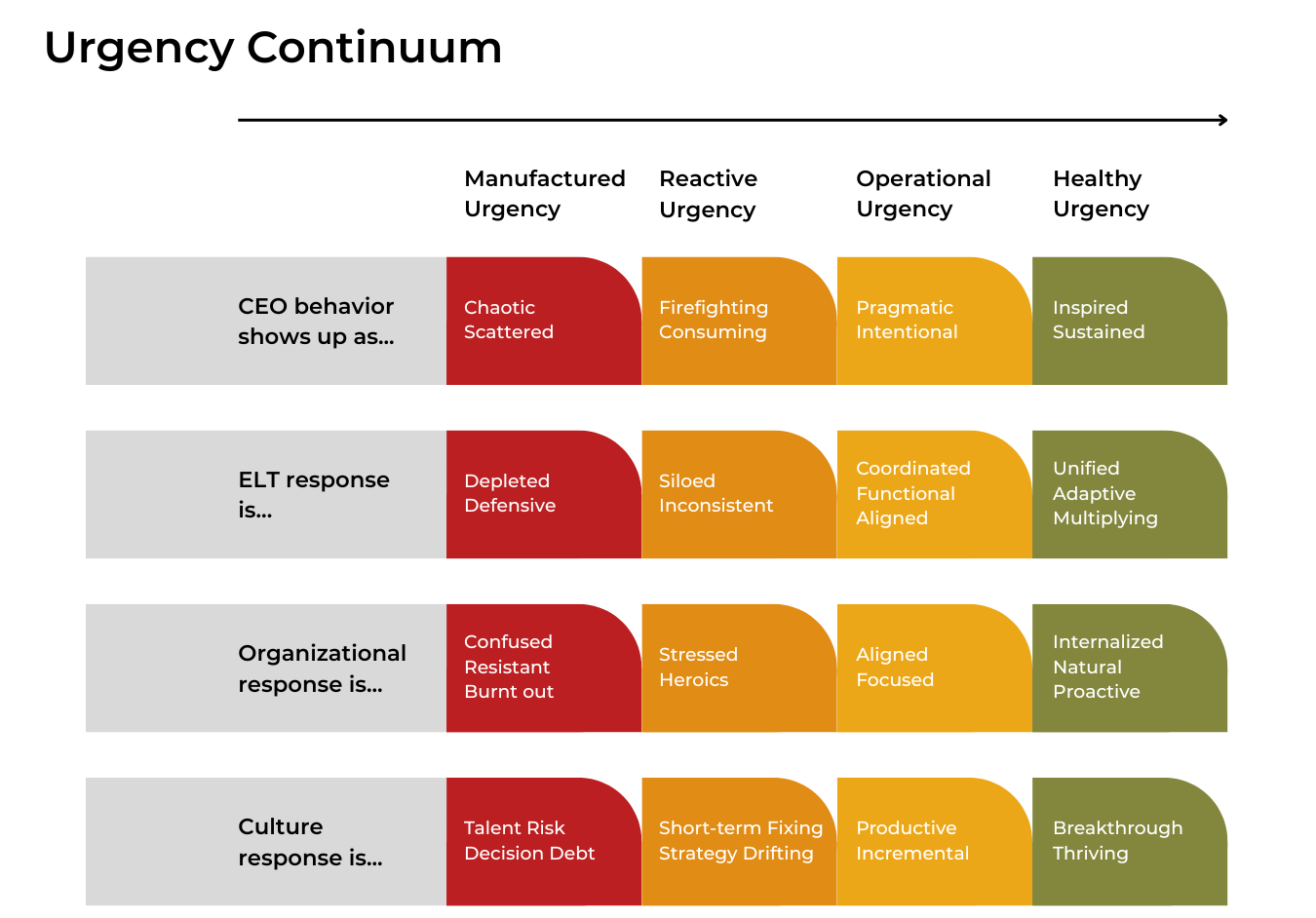We designed the 2025 CEO Summit to help portfolio CEOs develop, master, and embed healthy urgency into the DNA of the companies they lead. When CEOs create, channel, and sustain focused intensity that drives growth while building positive and sustained organizational capabilities and practices for competitive advantage, they are enabling healthy urgency.
As we finalized preparations for this year’s Summit, originally set in Kiawah Island, a tropical storm and parallel hurricane forecast forced a pivot to a virtual format. We had 48 hours to adapt. Suddenly, we weren't just teaching about urgency, we were living it.
It reminded me why this topic matters for growth-stage, PE-funded CEOs. Urgency isn't optional; it's baked into the business model from the moment the deal closes. Mastering it is the key.
The Paradoxes of Urgency
There is no leadership playbook for the current business environment as we move from a VUCA (Volatility, Uncertainty, Complexity, Ambiguity) to BANI (Brittle, Anxious, Non-Linear, Incomprehensible) world. In addition to the pressures to perform and shifting contexts, growth-stage CEOs face a range of urgency paradoxes:
- Speed vs. Accuracy: The faster a CEO needs to move, the more critical it becomes to slow down and get decisions right
- Urgent vs. Important: What feels most urgent often isn't what's most important for long-term success
- Communication: Urgent situations demand both immediate action and thorough stakeholder communication, which seem mutually exclusive
- Delegation: Crisis moments require a CEO to both take direct control and empower others to act independently
- Planning: The less time you have, the more essential planning becomes, yet planning takes precious time
- Transparency Trade-off: Urgent situations need both complete honesty and careful message management to avoid panic
- Resource Allocation: Emergency mode demands both focused allocation on the crisis and continued investment in other critical areas
The Urgency Thermostat
Kurt Lewin, the famed early 20th century social psychologist, coined the behavioral equation: B = f (P, E). Behavior is a function of who we are in the context of the environment in which we operate. Stated another way: How we think + how we behave = the impact we make. This equation is highly relevant for modern growth-stage CEOs, who must:
- Be a stabilizing and inspiring force in context
- Set the urgency temperature for the company
- Lead with clarity, direction, productive motion, and progress
- Balance intensity and recovery
- Attract and inspire people to own and act with agency
We introduced a central framework through an Urgency Continuum: a thermostat that shows how CEO behavior sets the temperature for an entire organization.

- At one end sits Manufactured Urgency: chaotic, scattered leadership that creates depleted, defensive teams and confused, burnt-out cultures. Everything feels like a crisis because the CEO treats everything as one.
- Move along the spectrum, and you hit Reactive Urgency: firefighting and consuming energy, with siloed teams engaged in heroics while strategy drifts.
- Further still is Operational Urgency: pragmatic and intentional leadership creating coordinated, functional teams and productive, incremental progress.
- At the far end lives Healthy Urgency: inspired, sustained leadership that builds unified, adaptive teams capable of breakthrough performance, where urgency becomes internalized, natural, and proactive rather than imposed and exhausting.
You, as the CEO, are the thermostat. Your team doesn't just hear what you say about urgency; they feel what you emanate. They read your energy, your decision patterns, your recovery rhythms. Whether you realize it or not, you're always modeling what urgency looks like.
Which leads to a growth-stage paradox truth: the very intensity that got you here can become the ceiling that keeps you here. The difference between companies that scale successfully and those that plateau isn't the absence of urgency; it's the quality of that urgency.
Finally, as a Summit prework assignment, we asked attending CEOs to assess where their company stood along the urgency continuum. On average, they identified as being in the mid-range of operational urgency. But it was clear that each CEO might adjust that rating if they considered their board, the executive team, or the overall company’s point of view.
A Foundational Challenge
Working in small, facilitated groups led by experienced board members and former Edison CEOs, we also presented what we call "The Sequence That Works".
- Clear Plan: What exactly are we achieving and why?
- Executive Ownership: Who owns what piece?
- Organizational Cascade: How does ownership flow down?
- Healthy Urgency: How does urgency become a force multiplier?
Most CEOs try to skip straight to step four. They attempt to create urgency without the foundation of clear planning and true distributed ownership. This doesn't create healthy urgency; it enables manufactured crisis.
One CEO participant put it perfectly during a breakout discussion: "I realized I've been using urgency as a substitute for clarity. When I don't know what to do, I just make everything urgent and hope the team figures it out.” That's the trap. And in a PE-backed environment where the clock is always ticking toward an exit, or another transaction, the temptation to manufacture urgency becomes almost irresistible.
This is where we posed a diagnostic question: When your team delivers on urgent projects, are you building organizational muscle or burning it down?
'Urgent People Systems' rely on individual heroics, burn out high performers, create single points of failure, and don't scale with growth. Urgent Operating Systems build urgency into processes, distribute capability across the team, create sustainable performance, and scale with organizational growth.
We asked participants to identify their top three "urgent people" dependencies: situations where urgent work depends on specific people working unsustainable hours. The discomfort in the (virtual) room was palpable. Most could immediately name names. The follow-up question landed harder: If your top performers quit tomorrow, could someone else deliver this type of urgent work?
Addressing the Question of Urgency Inside Your Company
Consider the following questions for reflection and discussion with your executive leadership team:
On your current state...
- What percentage of urgency in your company is strategic versus manufactured?
- How has team energy changed during your most recent urgent pushes?
- What decisions currently require your approval that could be made by others?
On your role as a thermostat...
- Which destructive urgency behaviors do you recognize in yourself? (Using "urgent" language for non-urgent issues, ideating in real-time with employees who might misinterpret this as a new project, changing priorities without a clear rationale, creating last-minute pressure through poor planning)
- What would your executive team say about your urgency temperature setting?
- Where is your anxiety amplifying into team urgency?
On sustainability...
- Can you sustain your current pace for 12+ months?
- What urgent work depends on specific people working unsustainable hours?
- How do you balance strategic work with urgent demands?
Actions to Take
Based on our Summit small-group conversations, we put forth a few practices to breed and sustain healthy urgency as CEO:
- Implement a 24-hour buffer between feeling anxious and declaring something urgent. This simple practice dramatically reduces manufactured urgency.
- Use the "1-3-5 rule" for priorities: 1 top priority, 3 important items, 5 everything else. Share this hierarchy explicitly and repeatedly.
- Create decision rights that let your team move without you. Map out what decisions can be made at what levels, with what dollar thresholds or impact parameters.
- Design operating rhythms that channel urgency productively. Weekly strategic reviews, monthly planning sessions, and quarterly strategic urgency assessments. Build the cadence that makes urgent work strengthen rather than disrupt strategic work in line with the speed of your business.
- Audit your urgent people dependencies and systematically convert them to processes. Your goal is capability that survives personnel changes.
The Storm's Lesson
As our weather-forced pivot taught us, healthy urgency isn't about perfect conditions. It's about clear thinking and disciplined execution under constraint.
Several participants said the intimacy of the virtual format actually improved the experience. Small group breakouts created safety for vulnerable peer-to-peer conversations. The constraint forced focus.
That's healthy urgency in action: not the absence of pressure, but the transformation of pressure into productive energy.
Your team is watching how you handle it. What temperature are you setting?


